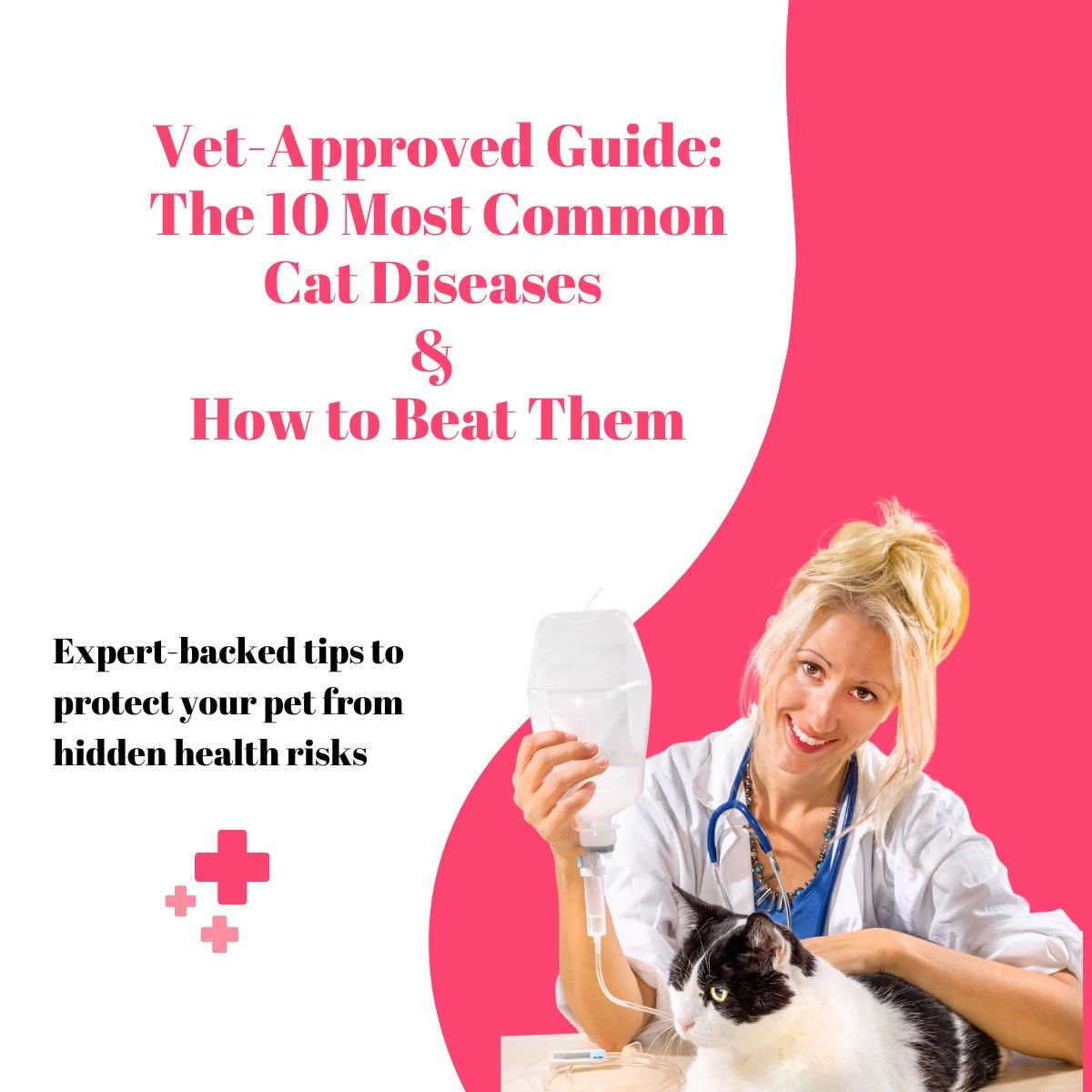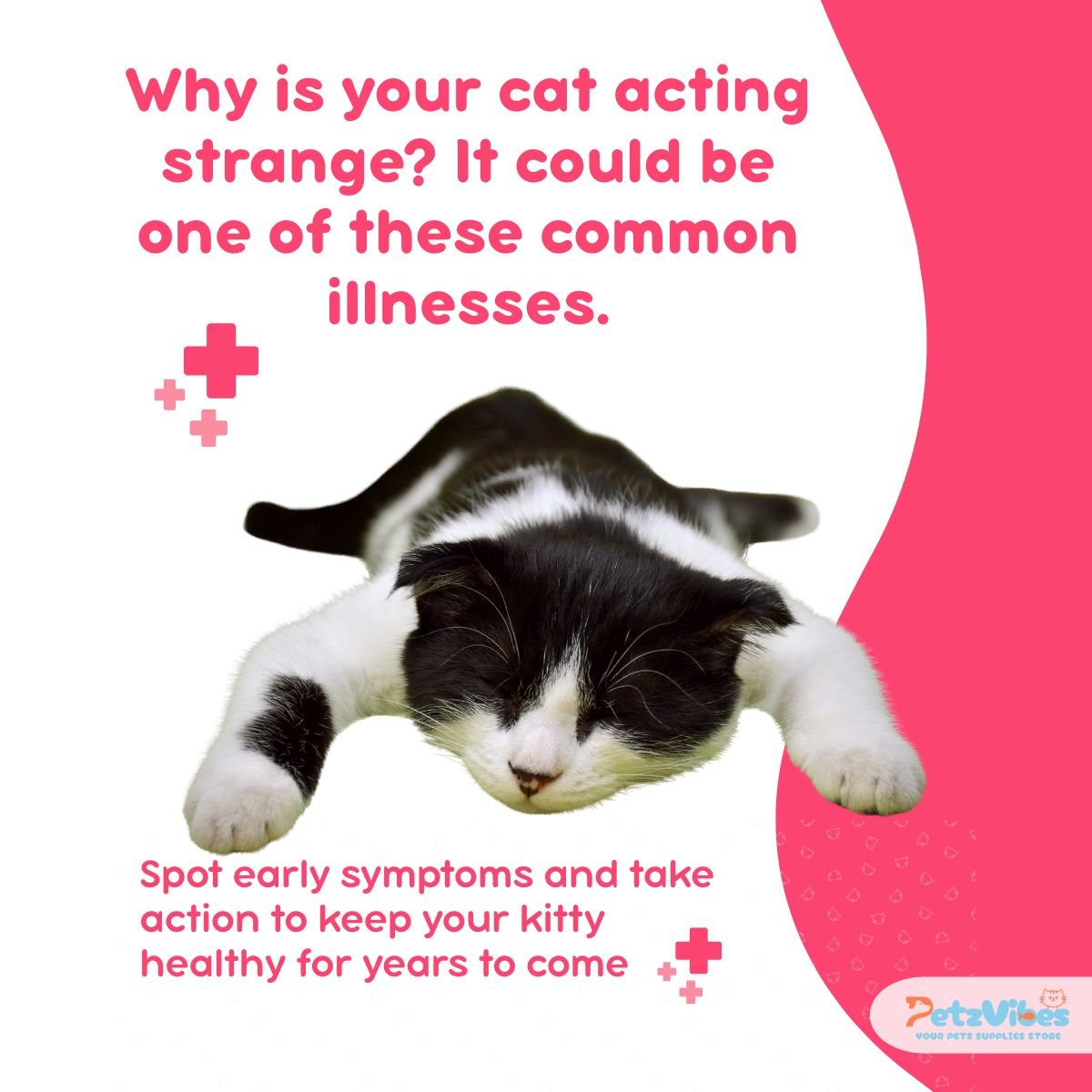Is your cat hiding symptoms of common cat diseases? Many feline health issues go unnoticed until they become serious, but early detection can save your pet’s life. As a responsible cat owner, knowing the signs, treatments, and prevention tips for the most frequent feline illnesses is crucial. From urinary tract infections (UTIs) in cats to feline diabetes symptoms, this guide covers the top 10 cat health problems, how to spot them, and expert-backed ways to keep your kitty safe.
Whether your cat is a playful kitten or a senior companion, understanding these common cat diseases—like kidney disease in cats, dental issues, or respiratory infections—can help you act fast and avoid costly vet visits. Let’s dive into the warning signs every cat owner should know and the best preventive care for cats to ensure your furry friend’s long, healthy life.
Understanding Common Cat Diseases
Cats, like humans and other animals, can face a range of health problems. Being familiar with the most common diseases can help you catch symptoms early and seek appropriate veterinary care. By understanding these conditions, you can become a more vigilant and effective guardian of your cat’s health.
Feline Upper Respiratory Infections (URIs)
Feline upper respiratory infections are quite similar to the common cold in humans. They are caused by a combination of viral and bacterial agents, with the feline herpesvirus (also known as feline viral rhinotracheitis) and feline calicivirus being the most frequent culprits.
Symptoms and Treatment of URIs
Symptoms of URIs in cats include sneezing, coughing, nasal discharge, and sometimes fever. While most URIs are not life-threatening, they can cause significant discomfort for your cat. Treatment typically involves supportive care such as maintaining hydration and nutrition, and in some cases, antibiotics for secondary bacterial infections.
Prevention of URIs
To prevent URIs, ensure your cat is vaccinated against the upper respiratory viruses. Also, maintaining a clean environment and reducing stress levels for your cat can help reduce the incidence of infections.
Feline Immunodeficiency Virus (FIV)
FIV is akin to the human HIV virus and affects a cat’s immune system. Although FIV-positive cats can live normal lives for years without symptoms, they are more susceptible to infections.
Symptoms and Management of FIV
Cats with FIV might not show symptoms immediately, but over time they can develop fever, swollen lymph nodes, and mouth infections. Currently, there is no cure for FIV, so management focuses on keeping your cat indoors, spaying or neutering to reduce aggressive behaviors, and monitoring your cat’s health closely.
Prevention of FIV
Preventing FIV involves keeping your cat indoors to avoid contact with FIV-positive cats. Spaying or neutering can also prevent some of the behaviors that lead to fights and bites, which are main ways FIV is transmitted.
Feline Leukemia Virus (FeLV)
FeLV is another serious viral infection in cats that can lead to cancer, anemia, and immune suppression.
Symptoms and Treatment of FeLV
Symptoms might include weight loss, lethargy, and pale gums. While no treatment reliably cures FeLV, supportive care can help extend a cat’s life and improve quality of life. This can include maintaining dental health and using medications to manage symptoms as they arise.
Prevention of FeLV
The FeLV vaccine is effective in preventing transmission and is especially important for cats that go outdoors. Keeping your cat indoors can also reduce the risk of encountering FeLV-positive cats.
Diet-Related Diseases in Cats
Diet plays a crucial role in your cat’s health. Improper feeding practices can lead to a range of health issues, some of which are discussed below.
Obesity
Obesity is a growing issue among domestic cats and can lead to other health problems like diabetes, arthritis, and heart disease.
Causes and Effects of Obesity
Overfeeding and a sedentary lifestyle are major causes of obesity in cats. Obesity can significantly shorten your cat’s lifespan and reduce its quality of life.
Prevention and Management of Obesity
To prevent obesity, provide a balanced diet suited for your cat’s age and activity level. Regular play and exercise can also help keep your cat at a healthy weight. If your cat is already overweight, consult your vet to develop a diet and exercise plan.
Diabetes Mellitus
Diabetes is another significant health issue that affects cats, particularly those who are overweight. It’s characterized by the body’s inability to properly produce or respond to insulin.
Symptoms and Treatment of Diabetes
Symptoms may include increased thirst and urination, weight loss, and increased appetite. Treatment often involves dietary changes and insulin therapy. Monitoring blood glucose levels at home is also an important aspect of managing the condition.
Prevention of Diabetes
Preventing diabetes in cats is largely about maintaining a healthy weight through proper diet and regular exercise. Ensure that your cat’s diet is balanced and consists of high-quality ingredients.
Parasites: A Persistent Problem
Parasites such as fleas, ticks, and worms are common in cats and can cause a range of health issues.
Fleas
Fleas can cause itching, skin allergies, and can transmit tapeworms to your cat.
Symptoms and Treatment of Fleas
A flea infestation typically causes excessive scratching, hair loss, and in severe cases, anemia. Treatments include topical and oral medications that your vet can recommend.
Prevention of Fleas
Regular flea prevention treatments, maintaining a clean living environment, and routine veterinary check-ups can help manage and prevent flea infestations.
Ticks
Ticks can transmit various diseases and are particularly dangerous if not detected early.
Symptoms and Management of Ticks
Ticks can cause local skin irritations and may transmit Lyme disease in specific regions. Regular checking of your cat for ticks, especially if they go outdoors, is crucial. Removal should be done properly to avoid leaving parts of the tick attached to the skin.
Prevention of Ticks
Tick prevention involves using tick control products, keeping your cat indoors, or checking for ticks regularly if they venture outside.
Worms
Intestinal worms such as roundworms, hookworms, and tapeworms are common in cats and can cause various health issues.
Symptoms and Treatment of Worms
Symptoms include diarrhea, vomiting, a bloated abdomen, and weight loss. Treatment usually involves deworming medications prescribed by your veterinarian.
Prevention of Worms
To prevent worms, ensure your cat’s environment is clean, use regular deworming treatments, and try to keep your cat from hunting or scavenging outside.
Dental Diseases in Cats
Dental health is often overlooked in cats, but teeth and gum diseases are quite common and can lead to serious health problems.
Periodontal Disease
Periodontal disease is a significant dental issue that can affect cats as they age. It starts with plaque buildup and can lead to gum disease and tooth loss.
Symptoms and Treatment of Periodontal Disease
Symptoms include bad breath, red or bleeding gums, and difficulty eating. Treatment involves professional dental cleanings and possibly tooth extractions if the condition is severe.
Prevention of Periodontal Disease
Regular brushing of your cat’s teeth and providing dental treats can help prevent periodontal disease. Routine veterinary dental check-ups are also essential.
Feline Tooth Resorption
Feline tooth resorption involves the breakdown and loss of a tooth’s structure and is quite common among older cats.
Symptoms and Management of Tooth Resorption
You might notice difficulty eating, oral bleeding, or jaw chattering. Unfortunately, the exact cause is unknown, but management often involves tooth extraction for affected teeth.
Prevention of Tooth Resorption
While prevention is difficult due to unknown causes, regular dental check-ups can help detect the issue early and manage it effectively.
Eye and Ear Problems in Cats

Eye and ear problems are common in cats, varying from mild irritations to more serious infections.
Conjunctivitis
Conjunctivitis causes inflammation of the eye’s mucous membranes and is one of the more common eye disorders in cats.
Symptoms and Treatment of Conjunctivitis
Symptoms include redness, swelling, and discharge from the eye. Treatment consists of cleaning the affected eye and using prescribed eye drops or ointments from your vet.
Prevention of Conjunctivitis
Preventing conjunctivitis includes maintaining good overall health with regular vet checks and ensuring your cat’s living environment is clean and stress-free.
Ear Mites
Ear mites are tiny parasites that cause discomfort and possibly infections within your cat’s ears.
Symptoms and Treatment of Ear Mites
You might observe your cat scratching its ears or shaking its head frequently. Black debris or discharge in the ears is also a common sign. Treatment involves thoroughly cleaning the cat’s ears and using medications to eradicate the mites.
Prevention of Ear Mites
Regular cleaning and inspection of your cat’s ears, especially if they spend time outdoors, can help prevent ear mite infestations.
Skin Conditions in Cats
Cats can suffer from a range of skin conditions that cause discomfort and require proper diagnosis and treatment.
Dermatitis
Dermatitis is an inflammatory skin condition that can arise due to allergies, parasites, or infections.
Symptoms and Treatment of Dermatitis
Symptoms include redness, itching, and sometimes flaking of the skin. Treatment depends on the underlying cause and could range from eliminating allergens to using anti-inflammatory medications.
Prevention of Dermatitis
Preventing dermatitis involves identifying and avoiding the causative agent, whether it’s a food, flea, or environmental allergen. Regular grooming and maintaining a clean environment can also help prevent dermatitis.
Abscesses
Abscesses in cats often develop from bites or scratches, leading to bacterial infections and pus accumulation.
Symptoms and Treatment of Abscesses
A noticeable swelling in your cat that may ooze pus, cause pain, or lead to fever is often an indicator of an abscess. Treatment typically involves draining the abscess and administering antibiotics.
Prevention of Abscesses
Reducing fights by keeping your cat indoors and ensuring your cat is up-to-date with vaccinations, like the rabies shot, can help prevent abscesses from occurring.
Conclusion
Caring for your cat involves love and companionship, and a keen understanding of common health issues and how to prevent them. By staying informed and proactive, you can prevent many diseases from affecting your cherished pet. Remember that regular veterinary check-ups, a balanced diet, and a safe and clean environment are crucial in keeping your cat healthy and happy. After all, a healthy cat is a happy cat, and your furry friend deserves the best care possible.






